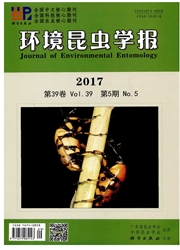

 中文摘要:
中文摘要:
为明确大气CO2浓度升高对外来入侵害虫西花蓟马Frankliniella occidentalis及其本地近缘种花蓟马F.intonsa的影响,利用两种CO2浓度(800μL/L vs.400!L/L)的人工气候箱研究了西花蓟马和花蓟马未成熟期的发育历期、累积存活率、单雌产卵量及净生殖率等种群参数。结果表明:在CO2浓度倍增条件下(800μL/L),西花蓟马和花蓟马的非成虫历期显著短于对照CO2浓度(400μL/L)下的种群;花蓟马的累积存活率比对照下降了26.30%(P〈0.05),而西花蓟马的累积存活率与对照差异不显著;西花蓟马的单雌平均产卵量比对照组增加了4.17粒,而花蓟马的雌成虫寿命、成虫平均单雌产卵量和日均单雌产卵量分别降低了1.31 d、4.83粒和0.56粒(P〈0.05)。与对照相比,高CO2浓度处理下西花蓟马种群的净生殖率(R0)、内禀增长率(rm)和周限增长率(λ)均显著增加,而平均世代周期(T)、种群加倍时间(t)均明显减少;而花蓟马则相反,其种群的R0、rm和λ均显著降低,T和t均明显长于对照(P〈0.05)。在相同CO2浓度下,西花蓟马的非成虫虫态历期短于花蓟马;两种蓟马非成虫虫态的不同发育阶段存活率由高至低的顺序相同,依次为:蛹期〉预蛹期〉2龄若虫期〉1龄若虫期。研究结果说明入侵种西花蓟马对未来高CO2浓度大气环境的适应性强于本地种花蓟马。
 英文摘要:
英文摘要:
To investigate the indirect effects of elevated atmospheric CO2 concentration on invasive thrips Frankliniella occidentalis and the local related species F. intortsa, developmental period of immature stage, survival rate, reproduction and population parameters of the two thrips species were measured under two atmospheric CO2 concentrations (800 μL/L vs. 400 p,L/L) in artificial climate chamber. The results indicated that, at doubled CO2 concentration (800 μL/L), the developmental durations of immature stage of F. occidentalis and F. intonsa were significantly shortened; the cumulative survival rate of F. intonsa decreased 26. 30% (P 〈 0. 05 ), while it showed no significant difference for F. occidentalis ; the fecundity of female F, occiden~lis increased 10. 93% , while female lifespan decreased 1.31 d, the average fecundity and daily eggs laid by individual female of F. intonsa decreased 4. 83 and 0. 56 eggs, respectively ( P 〈 0. 05 ). The net reproductive rate (R0 ), intrinsic increase rate ( rm ) , increase rate per unit (A) of F. occidentalis under high CO2 concentration were significantly higher than those under normal CO2 concentration (400 μL/L), with the generation time (T) and time of double population size (t) of this thrips significantly decreased. However, Ro, rm, and k of F. intonsa, on the other hand, significantly decreased, with T and t of this thrips increased (P 〈 0. 05 ). At the same CO2 concentration, immature stage of F. occidentalis was shorter than that of F. intonsa, survival rate of different development stages of the two thrips species showed the same order as : pupal 〉 pre - pupal 〉 2nd instar nymph 〉 1 st instar nymph. In conclusion, F. occidentalis might be more adaptable than F. intonsa under future CO2 -enriched environments.
 同期刊论文项目
同期刊论文项目
 同项目期刊论文
同项目期刊论文
 Genetic diversity of the planthopper, Sogatella furcifera in the Greater Mekong Subregion detected b
Genetic diversity of the planthopper, Sogatella furcifera in the Greater Mekong Subregion detected b 期刊信息
期刊信息
